Charlie Noble works in visual effects for over 15 years. He joined Double Negative at its beginnings in working on PITCH BLACK. He will participate by result in numerous projects from studios like ENEMY AT THE GATES, FLYBOYS or THE DARK KNIGHT. He has also supervised THE BOURNE ULTIMATUM directed by Paul Greengrass, that he meet again on GREEN ZONE.
What is your background?
2D. Film opticals, Parallax Matador, Cineon, Shake
The VFX of GREEN ZONE are almost all invisible. What have you done on this movie?
Thank you. Only “almost”? (laughs)
I think of any work that I’ve been involved with over the past 20-odd years, I am most proud of what Double Negative delivered for Greenzone. There are around 650 visual effects shots in the movie, a handful being all CG. Our task was to take the Spanish, Moroccan and UK locations and root them firmly in the Iraq of April 2003. All the damaged buildings, aircraft ( apart from one Puma ) and tanks were ours, as were a lot of the palm trees.
What references did you have to rebuild Baghdad?
We did a considerable amount of internet trawling for reference images from the first half of 2003. As quite a few of the landmark Greenzone buildings have changed since the war, it was important for us to start out from as accurate a place as possible. Using an in-house photogrammetry tool, “dnPhotofit”, we could extrapolate dimensions of building using just a few images.
Most textures were hand painted, derived from web-sourced images. To better support the narrative, we subsequently increased the level of damage on a few key buildings to really underline the destruction that was wrought in the Shock and Awe bombing campaign that began in earnest on 21 March 2003.
Have you used previz on the set to help the director and his cameramen?
A few big establisher shots were previzzed but for the most part, the nature of the show didn’t really lend itself to that level of shot planning from a vfx point of view. What we did do was to take previz quality versions of all our buildings on location with us to use as a live virtual set . Courtesy of Stein Gausereide, at any given location we would set up our camera and snap our cg model to the environment. The camera had IMU’s (accelerometers) attached to all 3 axis, with this data being fed into the maya camera. Paul and the camera operators could then pick up our camera and wave it around the location and see live what our additions were going to be, with the maya output layed over the feed from the camera.
The shooting style of Paul Greengrass is very frenetic. Your matchmove and roto artists should have lost their hairs. How did you manage these aspects?
Greenzone was our third picture with Paul Greengrass, after United 93 and The Bourne Ultimatum, so we knew what we were up against with regards matchmoving. The main thing that we have learnt over the years is to record as much camera info as physically possible when shooting. As 90% of the film was shot with zoom lenses, it was vital that we knew the focal length of each frame. To assist here we built encoders that the very helpful camera dept allowed us to mount on their matte rails. These were basically toothed wheels that locked into the focal length ring and whenever the focal length changed, the ring turns, turning our wheel which sends its data down a line to a laptop that our matchmovers carried behind the camera. After a couple of weeks the equally helpful Dragon Grips, kindly offered to carry the laptops for us ( mainly to get us out of the way ! ), before we modified the systems to operate wirelessly. Once back in the UK we shot grids for each lens moving through the zoom range. This gave us accurate focal length measurements for any given position on the ring and a corresponding distortion solve, to enable us to apply the exact lens distortion to the CG for any given focal length.
In addition to one matchmover per camera on-set, we had another matchmover with a Leica TotalStation, surveying each set and start/end camera positions for each take. Once shots come in, a focal length curve is derived from the on-set data, to produce an undistorted plate with accompanying zoom curve. The matchmovers then typically used dnPhotofit to snap the photography to our surveyed sets, to achieve the matchmove. This all makes it sound much easier than ,of course, it was given the low light conditions and extreme motion blur in some shots! Hats of to all the matchmove crew, led by Dan Baldwin. They did a terrific job.
Once over the matchmove hurdle, the next task was to split the live action up into its relevant layers to enable it to be sat into the virtual environment. One of the fairly atypical aspects of the set extension work on this show was that there is never a clear line between photography and CG, the CG often starts by camera and extends to the BG with the live action rotoed in and amongst it.
We were fortunate to have some highly talented roto artists on our crew, a number of whom have now gone on to form the core of our new office in Singapore. All rotoscoping on the show used Noodle; our in-house roto tool.
Whilst essential to the process, roto only gets you a certain part of the way and its up to the compositors to bring back all the edge detail from the original plate, using all manner of keys, filters and, sometimes, painting. There was nothing easy about any step of the process and even with the best pipelines in the world, it still comes down to some very talented artists working very hard.
How did you recreate the « Shock and Awe » sequence?
The final high wide in the Shock and Awe sequence was an extremely important shot to really demonstrate the enormous scale and unimaginable force of the missiles that rained down on Baghdad around 21 March 2003. We can all remember the footage beamed from the Palestine Hotel where most foreign journalists had been corralled.
The shot starts as Al-Rawi’s convoy of 4×4’s pull out of his gate at speed and the camera rises up from 5ft to 200ft to witness Baghdad under bombardment. We shot a plate of the cars coming out of the gate with a 50ft crane up, on location in Morocco.
This served as invaluable reference for the shot which ended up being entirely CG, due to the need to extend the camera move up and to wash the foreground with light from the mid ground CG explosions.
The huge smoke plumes that we see were created using our in house fluid solver dnSquirt and some maya fluids, rendered with our renderer; dnB. We actually sculpted all these vast plumes to match the size and shapes that we saw in the footage from the real thing. Exploding buildings were achieved with our in house rigid body solver “dynamite”. Hundreds of passes were rendered out; volumetric atmospherics, lighting passes, smoke, fog, explosions, fire, tracer, buildings, exploding buildings, trees (lots of trees, all gently animating), the Tigris river, foreground cars, exhausts, dust kicked up from the road, etcetc. There were about 150 layers each with secondary lighting passes and IDs all expertly knitted together by Sean Stranks in comp, CG by Dan Neal and FX by Mike Nixon. In addition, on this sequence, our work actually started inside the house as Al-Rawi prepares to leave. We added falling dust and damage to the walls, then when we come outside, we added tracer arcing up into the sky, illuminating CG trees which we added around the courtyard. We also added reflections into car windows of what we were about to see in the high wide. All quite subtle stuff but vital to keep up the energy of this opening scene. We used Houdini L systems for all the trees which provided a useful layout tool. The L systems trees were baked out as a series of rib archives with varying levels of dynamics to simulate anything from gentle wind to chopper wash, so that the animators and the layout artists could pick up pre-animated trees and place them into their Mata scenes using simple bounding boxes for placement. At render time the curves become trunks, fronds and leaves using custom in-house shaders which created displaced surfaces from the curves.
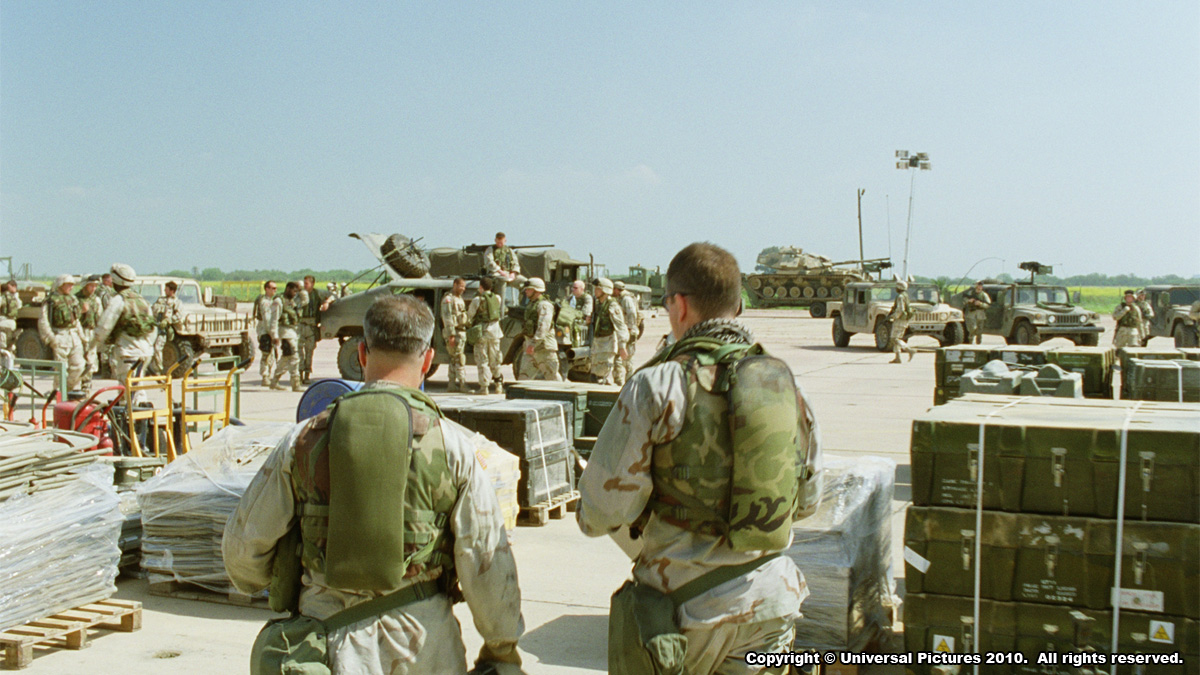 |
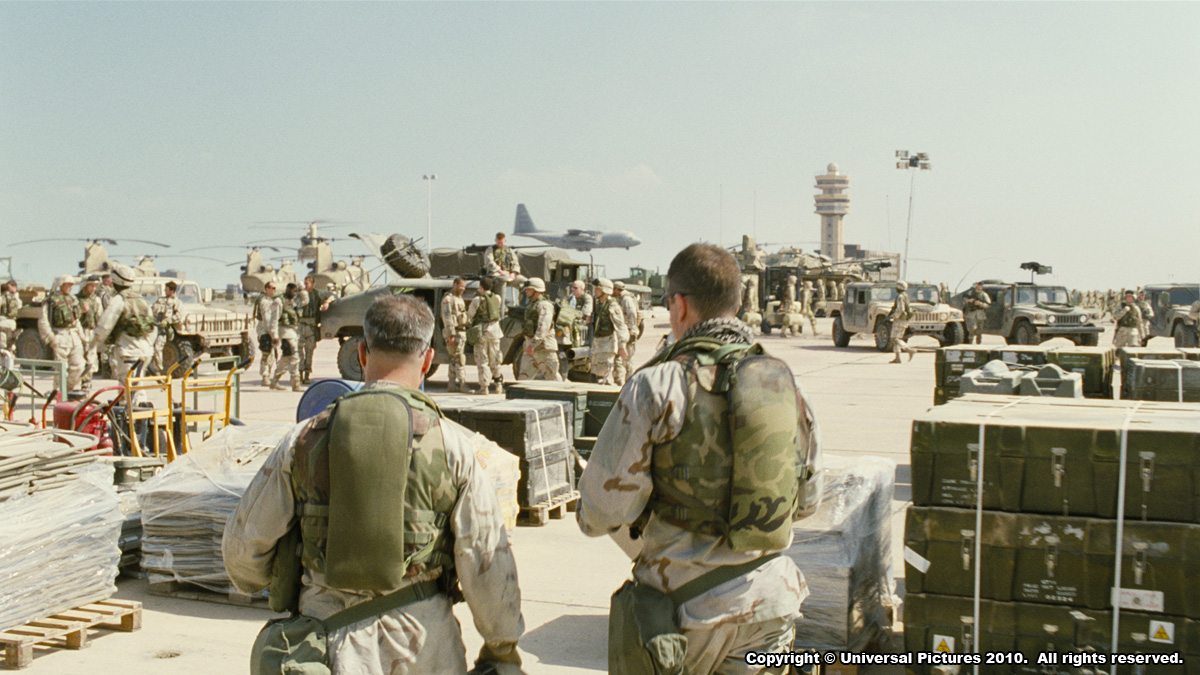 |
Can you tell us more about the airport’s sequence?
The airport scene really encapsulates our work in Greenzone. We’re taking the Moroccan location and plonking it right slap airside in front of what was Saddam International Airport in Baghdad. The arrival of Zubaidi was shot the same way Paul likes to shoot all his dialogue scenes, the action is allowed to play out for nice long takes with 2 cameras on short zooms in and amongst the action and one long lens off to one side, with cameras sometimes leap frogging – one re-loading while the other carries on. The scene was shot on an open expanse of tarmac at an airbase north of Rabat. Faced with this style of filming, multiple cameras all looking 360 degrees throughout takes, it was clearly not an option to rig a few miles of bluescreen, half a mile high round the action, so the roto and comp artists really came into their own here. Matt Smith built the airport and was the CG lead for the sequence. Again, the internet was trawled for reference images from the time and these + dnPhotofit were used as layout and modelling guides. Everything was modelled from scratch and textures hand painted. There had been a fire-fight at the airport but we added extra damage to the terminal building to support the narrative. This damage was achieved by using the last frame of a rigid body simulation. This scene features the only real chopper in the movie – the Puma that Zubaidi lands in. All other aircraft in the film are CG; Blackhawks, Chinooks, C-130s etc. The opening aerial shot is all CG and has all our CG hardware on the tarmac and unloading from C-130’s; Fork-lifts, 5-tonners, Humvees, HEMTs, Bradley tanks, Abrams M1A1 tanks, diggers, Iraqi civilain cars, US gvt SUVs and landrovers along with a few hundred soldiers.
Once on the ground, we have a shot of Zubaidi’s Puma landing, escorted by a CG Chinook in extreme foreground and another behind it.
This sequence was another matchmove challenge, with handheld zooming cameras and just tarmac and sky and 30 or so milling journalists. We had the immediate tarmac, the Puma, the Journalists, a couple of Humvees and 2 tents, everything else is CG. Comp lead was George Zwier who did a great job.
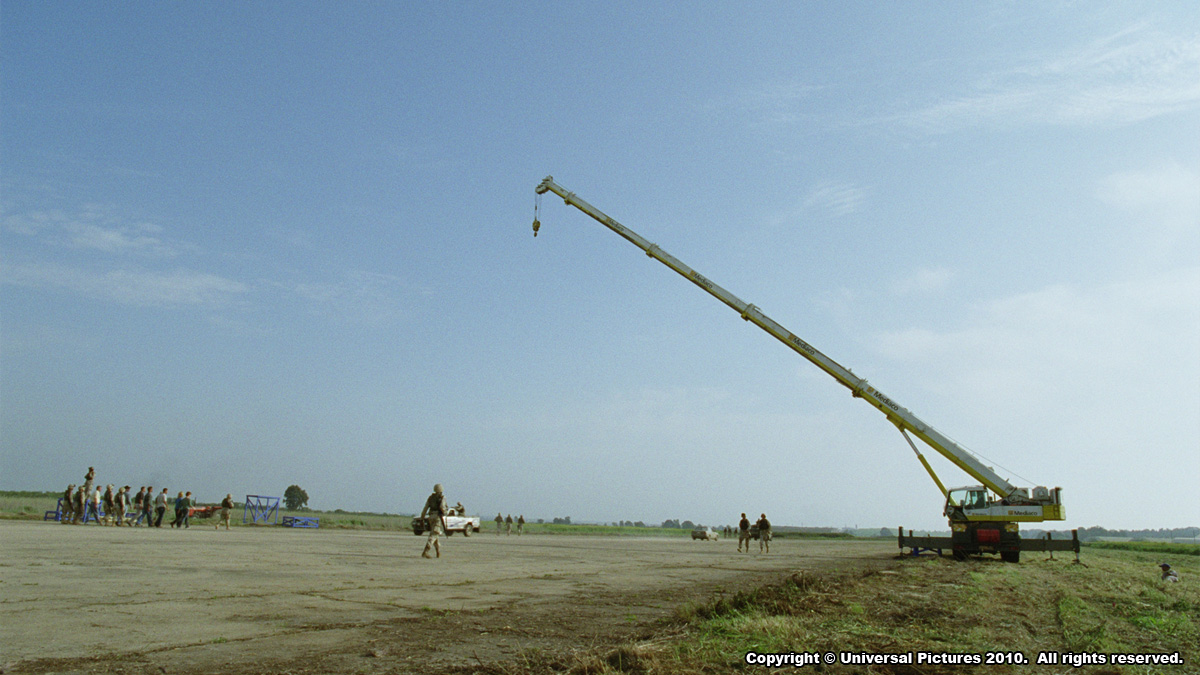 |
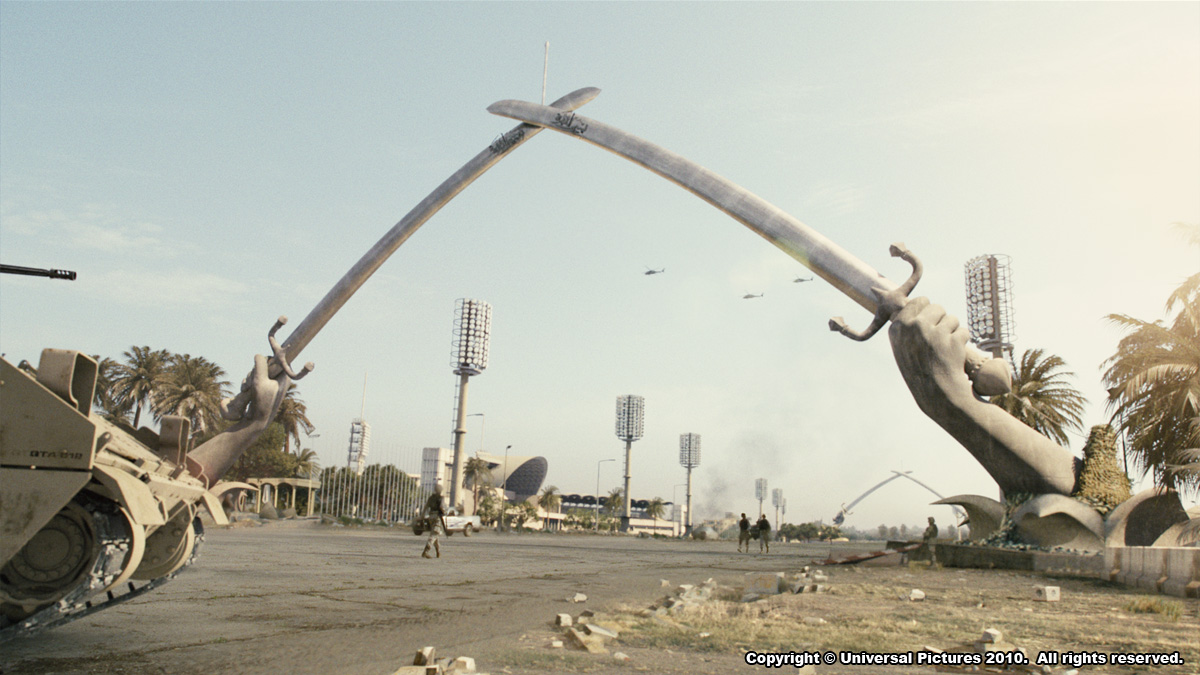 |
How did you create the Assassins’ Gate?
This shot was re-purposed slightly in post. We shot on a broad leaf tree lined avenue in Rabat. It was actually the road that leads up to the Royal residence. We knew where we were going to place the CG Assasin’s Gate and construction had positioned 2 containers one on top of the other either side of the road with a black drape hung between them to cast the correct shadow onto anything that was to pass underneath the Gate. We marked out the footprint of our model on the road and positioned 20ft green poles at each of the corners. We also had our virtual set mix/overlay system with us so everyone could see what we’d be adding. The Gate itself was beautifully modelled and textured by Tom Edwards from web sourced images and hand painting. Paul really wanted to underline the damage that had been inflicted on the key gvt. buildings in the Greenzone and so we stripped out the real trees, added huge damaged buildings back from the road and dressed in palm trees lining the avenue. We also added fg tanks, razor wire, Greenzone sign and Bradley tanks complete with driver – we had the frame work for the tank constructed from 4×2″ panted blue so the driver was standing at the correct height. Another lovely composite from Sean Stranks.
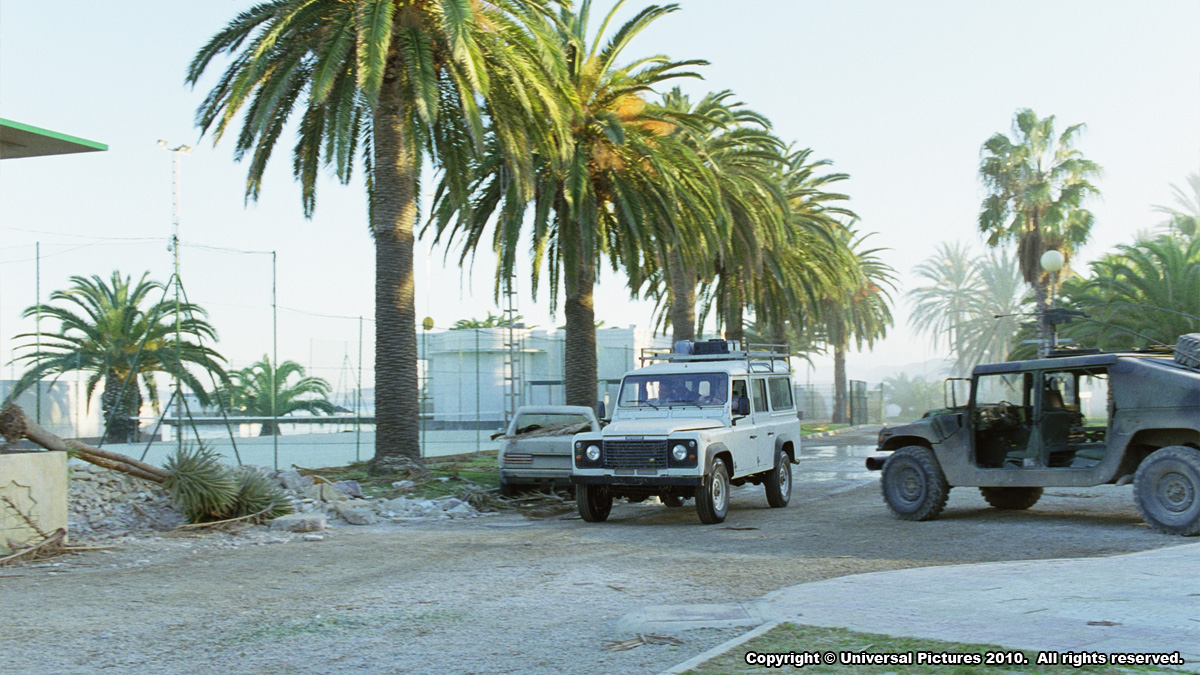 |
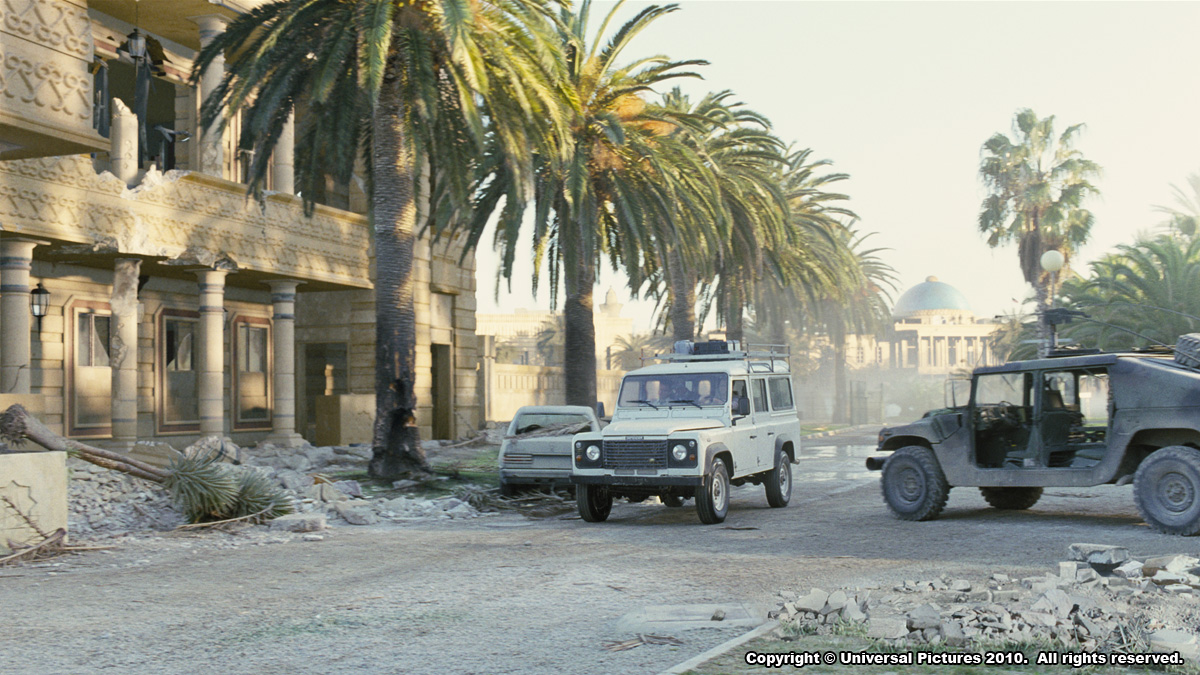 |
Can you tell us how you create shots in the Green Zone in particular
We were keen to be as accurate as possible to the geography of the GreenZone. Our CG co-supervisor, Julian Foddy, became something of our tour guide, making sure that the key buildings were layed out correctly. We started modelling key government buildings way before the shoot and because we weren’t too sure of shot design they were all modelled and textured to a high LOD.
When it came to using them we would typically take a digital wreaking ball to them to match ref photography or dress in specific art directed additional damage to better suit the composition of the shot. Theres a great Miller POV shot on the way to the Palace where we start out looking out of the side of his Humvee before panning round to look out the front. We shot on a nice open boulevard in Rabat with a road dressed with sand, but apart from the immediate fg Humvee and the road, everything outside is CG, all the damaged buildings, trees, passing Humvee on the other side of the road and the distant Palace. Here’s an explanation from Julian describing how he approached the damage: “We used custom mel scripts, coupled with a dneg proprietary boolean plug -in, that allowed us to use a geometry plane as a ‘knife’ on other geometry. Firstly the building was modelled intact. The modeller would then take a high resolution plane, and add noise and undulations to the plane, similar to the line of a crack or shatter. This plane was the positioned intersecting the wall where we wanted the damage to be, and the scripts run to slice the wall into two pieces. This process was repeated over and over, until walls had been ‘blown to pieces’. Another in house tool ‘dynamite’ was then used to dynamically scatter chunks of the wall and other associated debris onto the ground. ”
What about the shots of the Palace and the poolside?
The shots outside the front of the Republican Palace were shot in southern Spain on an airbase. Art department constructed the front door and portico in front of a large white building of approximately the same height as the real thing in Baghdad. We marked up the driveway
on the location and any other CG additions that the action would come close to (or have danger intersecting with). We also had our virtual mix/overlay system with us. This was really important as a framing guide for this sequence as for one of the angles we had the CG gardens in foreground with the live action in the mid ground and CG Palace behind. So, in addition the the Palace, we have CG grass, trees, shrubs, and fountains in foreground , layed out as per the real thing using Googlearth and the copious reference photography that exists for this location, as well as CG midground vehicles and CG soldiers.
 |
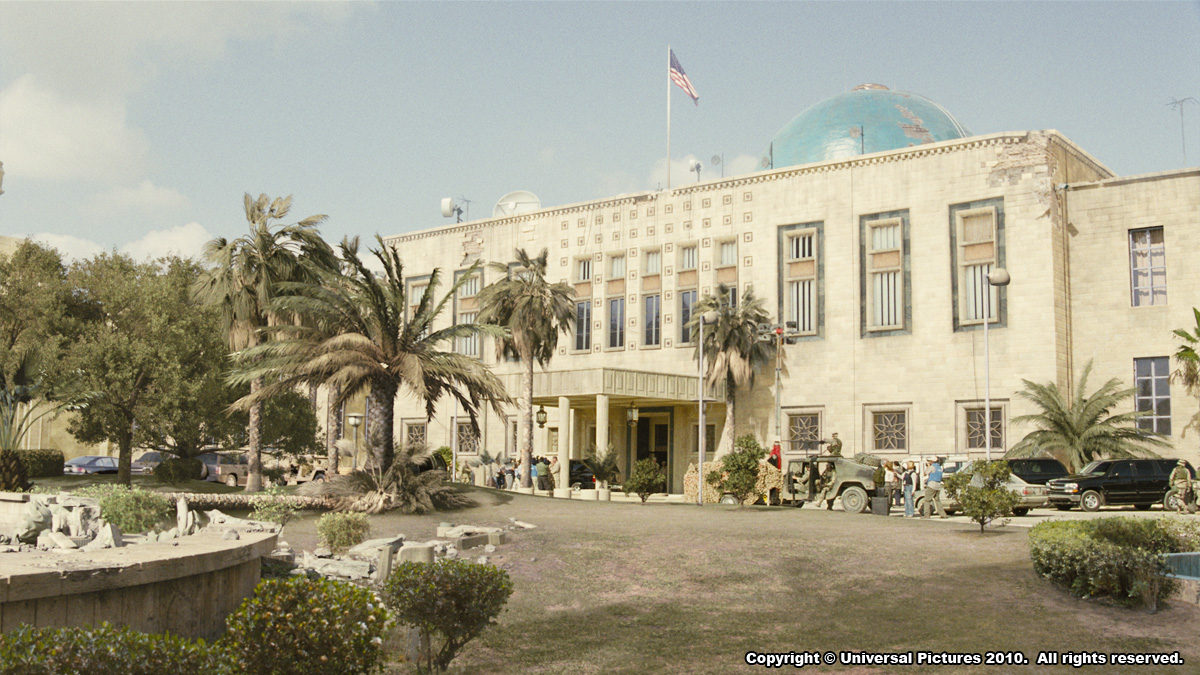 |
Was the flyover shot over Baghdad and the Green Zone 100% CG?
A helicopter plate filmed in Morocco for the beginning of the shot served as the only live action element. The shots begins with a ground rush of urban Baghdad, before the camera tilts up to reveal the expanse of the Greenzone. The camera travels over the crossed swords of Qadisiya, past the UFO-like tomb of the Unknown Soldier and bomb damaged ministerial complexes before honing in on Saddam’s Republican Palace. Apart from the first 150 frames, which is mainly a retimed and re-projected version of the Moroccan plate, the shot is entirely CG. Julian Foddy lit and rendered all the CG for this shot (he modelled a lot of it too and did a fair amount of the texturing ) – pretty Herculean. Graham Page composited it. I did ask him how many layers he had to deal with and I’m told it was around a hundred but with each of those layers being made up of auto-precomped layers, its pretty hard to put a figure on it. Theres in excess of 500,000 frames of CG in the shot amounting to 5 TB of data. The vast ground expanse was textured in camers space by Tim Warnock. Jules used a “brick mapping” approach to overcome the challenge posed by the 38,000 trees in the shot. This meant we were rendering high detail point clouds rather than actual geometry, so we moved seamlessly through varying levels of detail as the trees grew nearer camera. Tonnes of extra detail was added with the addition of buses, people, cars, choppers, smoke from smouldering buildings and FX atmospherics passes from Federico Frassinelli.
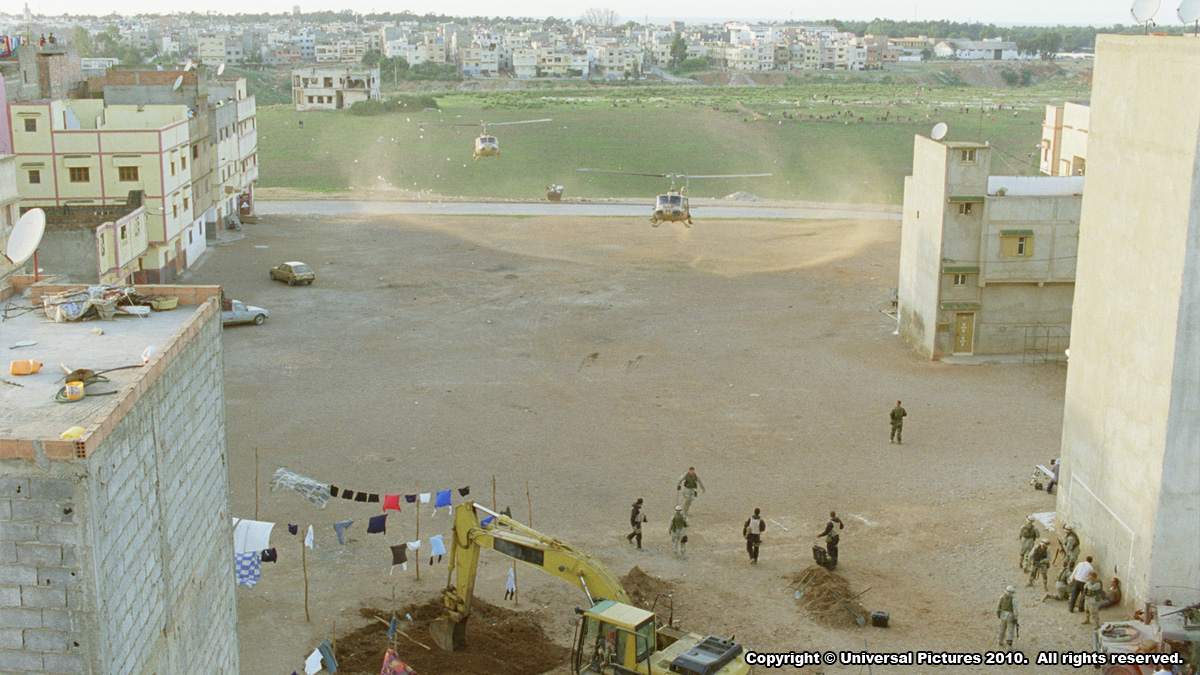 |
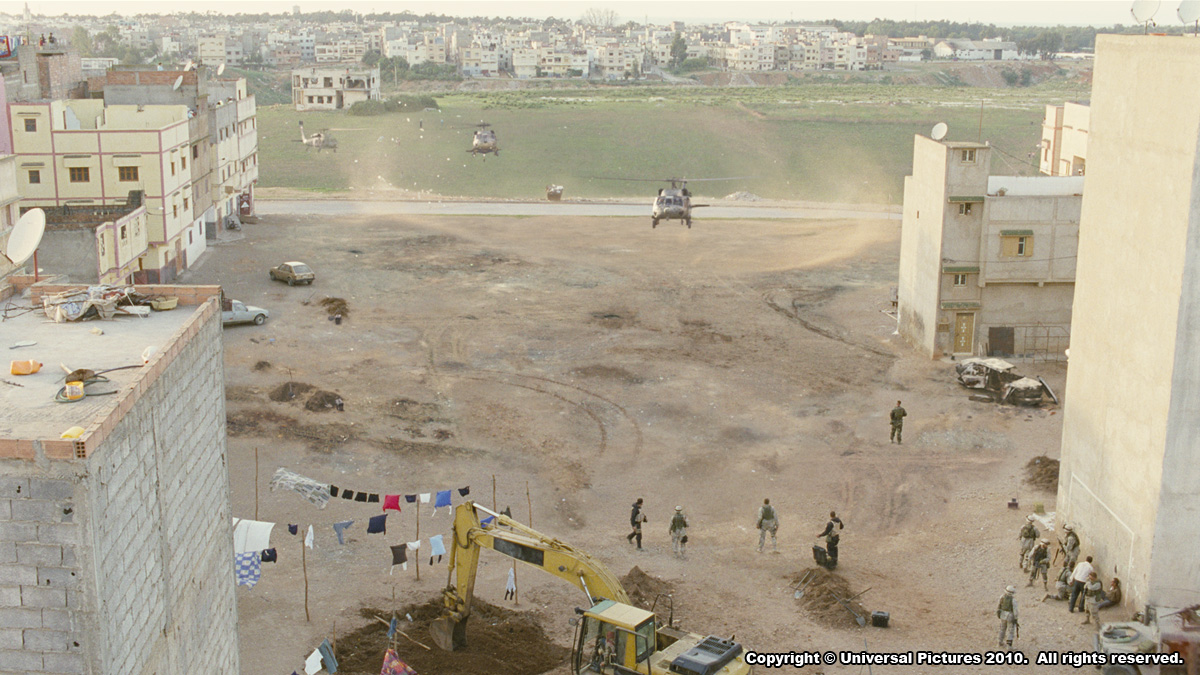 |
Why and how did you recreate the Black Hawk helicopters?
We couldn’t get hold of the real thing and even if we had you can understand the authorities being reluctant to let us fly them around over their capital city but as we had shots of Special Forces teams getting in, out, taking off and landing in real helicopters we had to film with something practically. Fortunately for us, the opening on a Huey is of a similar size and the Moroccan airforce kindly made 2 available to us. Having a real helicopter was really the only way to do these shots. You have something the approximate size that kicks up all the right atmos – has the right presence and forces a level of authenticity that would otherwise been hard to achieve. They were modelled from scratch using rough dimensions gleaned from the internet and using photogrammetry coupled with loads of internet stills. We finished them to a very high level of detail as in some shots we run right up to the door – 3 ft away from camera. They were lit by Bruno Baron who is a genius. The choppers look amazing. The compositors had to work hard to integrate the CG choppers into the shots, keeping as much of the real dust/atmos as possible but also using CG FX dust from Federico and Mike Noxon to bed them into the plates. The FX work is also critical to these shots, matching their sims perfectly to the practical. The choppers also have CG pilots up front animated by Will Correia. The daytime scene when the SF team land on the dusty soccer pitch and snatch Millers prisoners was one big CG chopper moment. Another takes place at night as they race from their base, across the tarmac and into their blackhawks. For this scene we just had the one Huey, one light and our 6 foreground SF team. Everything else was CG; the base, the perimeter fence, bg vehicles, the hero blackhawk that we run up to and the 2 other blackhawks complete with digi doubles running across the tarmac. Its fair to say that these shots were testing for all departments particularly matchmove – not much to track and roto – black shapes against black.
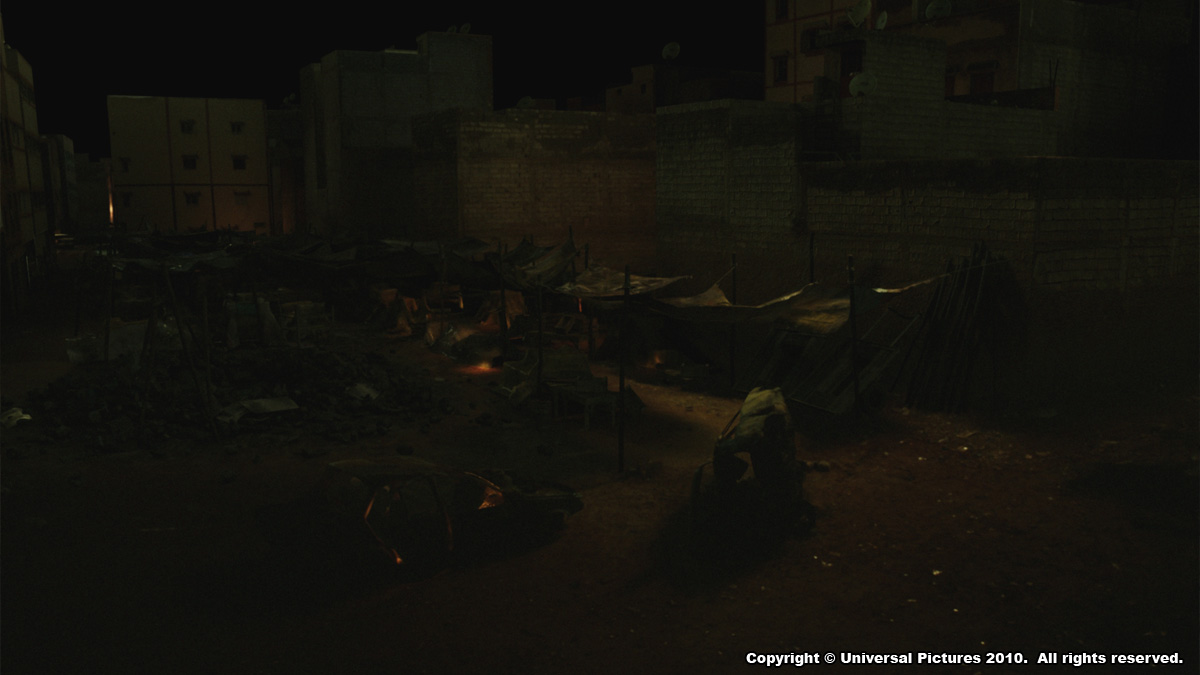 |
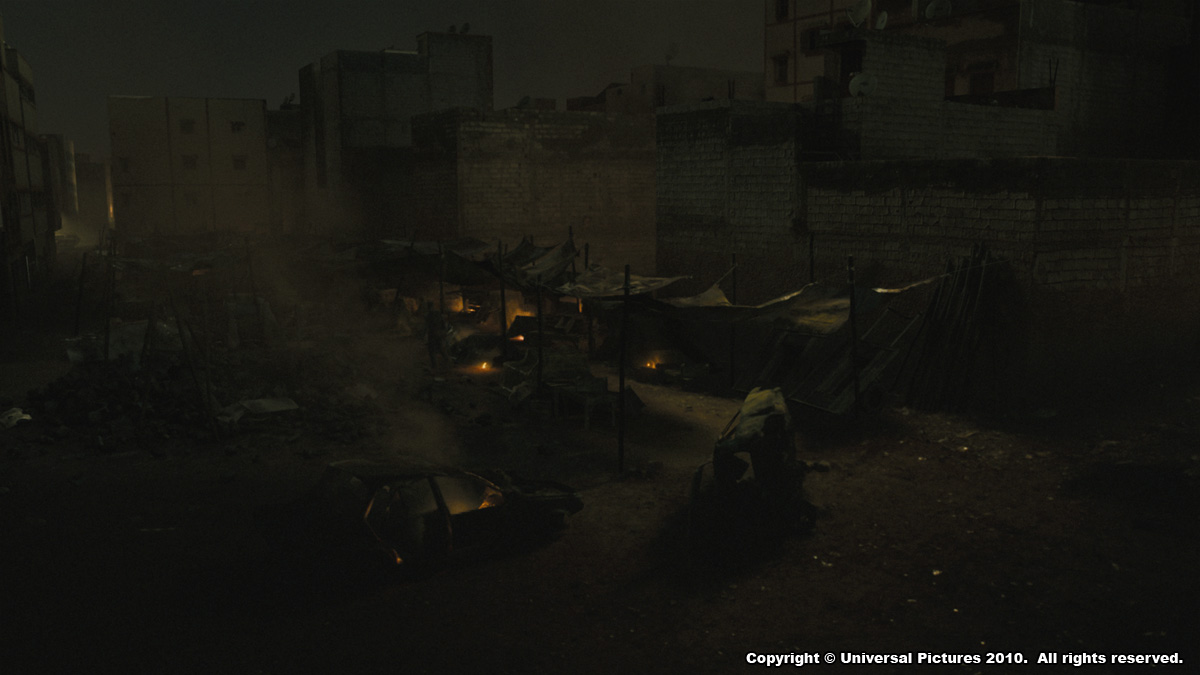 |
Is the night shots like the market has been easier to create?
The crane up at the end of the market-place stand-off was modelled, lit and rendered by co-cg supervisor Dan Neal and composited by Walter Gilbert. The only real thing in the shot is the rotoed element of Miller walking away from camera. Tom Edwards surveyed the set and took a number of high res tiled panoramas of the marketplace and surrounding buildings as well as a number of HDR spherical lighting images. What you see is the result of a fairly immense job from Dan from all the market-place structure – loads of boxes, wooden posts, tarpaulins, fires, smoke and buildings to the arriving Humvees and troops that get out and run into the square, the choppers, explosions, tracer. Its another kitchen sink shot!
What was the most complex sequence?
The most complex shot has to be the flyover. As far as sequences go they were all complex.
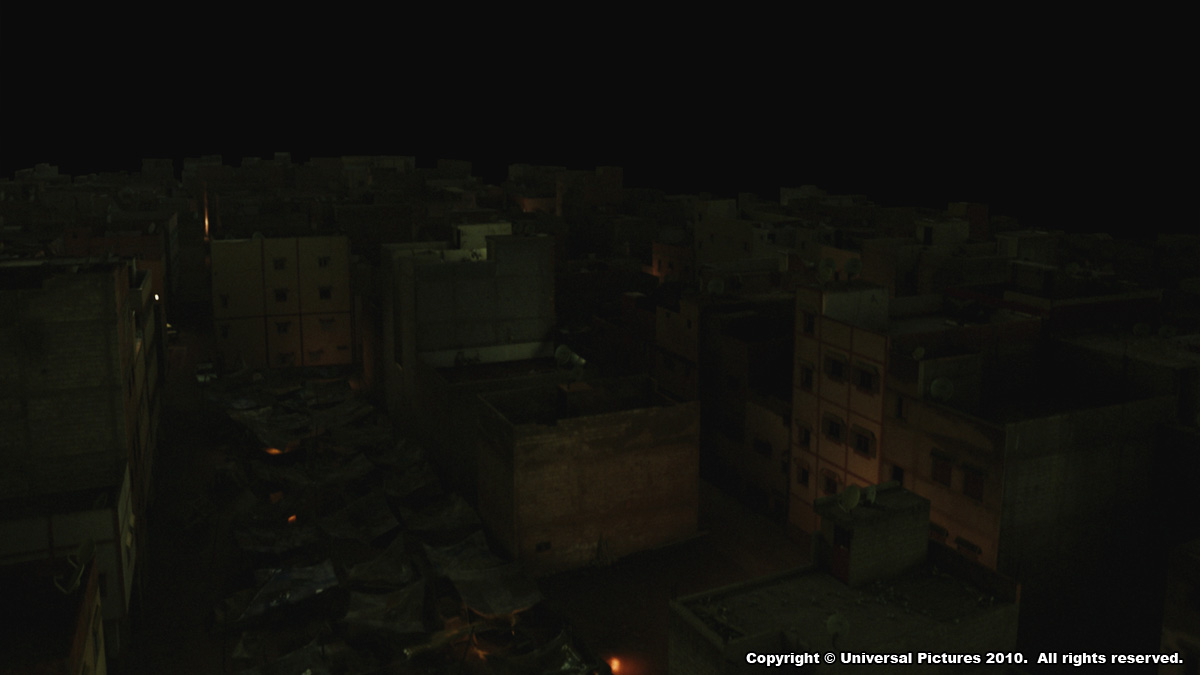 |
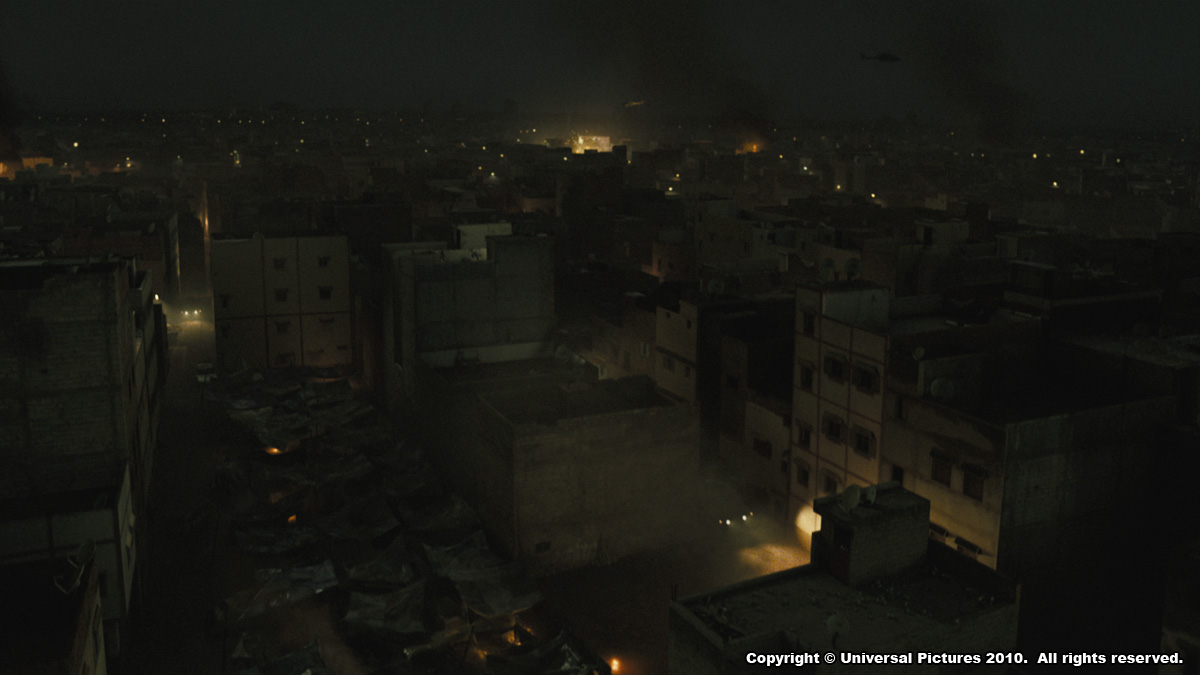 |
What do you remember this movie?
A really great crew – both shooting and in post.
What is your next project?
My garden. I’m helping out round the company doing bits and pieces at present, a bit of ATTACK THE BLOCK, a bit of HARRY POTTER, some INCEPTION, some bidding.
What are the 4 movies that have given to you the passion for cinema?
Thats a tough one.
CASABLANCA, KES, MARY POPPINS, UNFORGIVEN, TOY STORY. I’ve given you one extra.
Thanks for your time.
// WANT TO KNOW MORE?
– Double Negative: Dedicated page to GREEN ZONE on Double Negative website’s.
© Vincent Frei – The Art of VFX – 2010


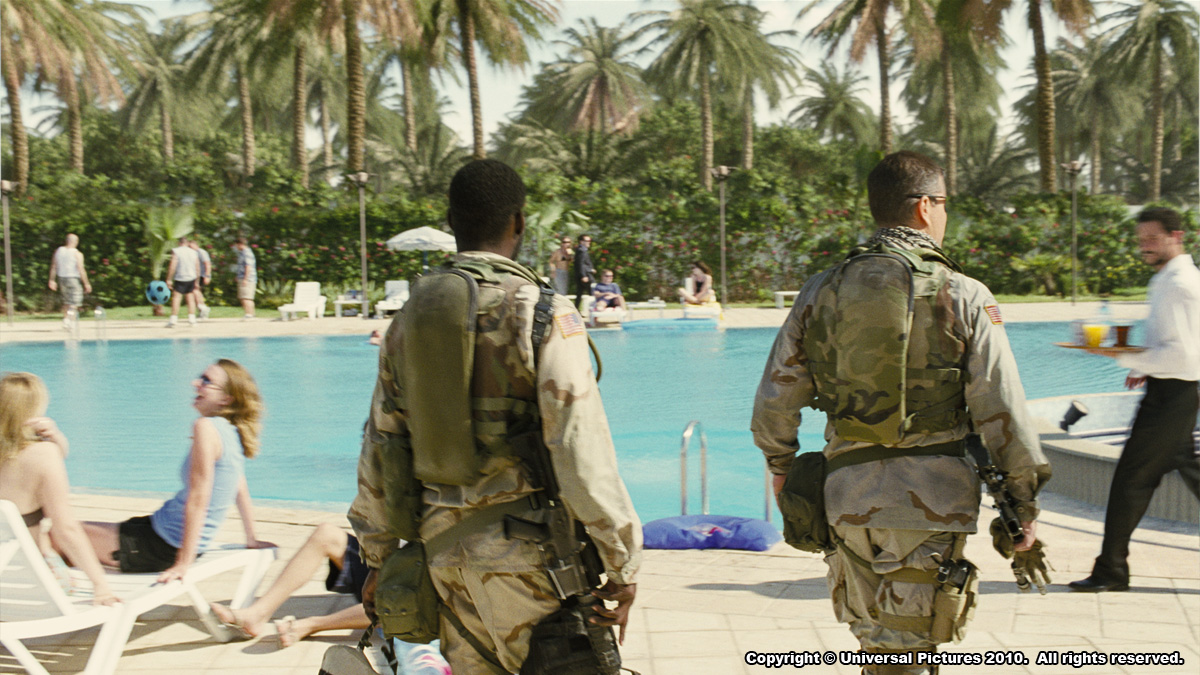
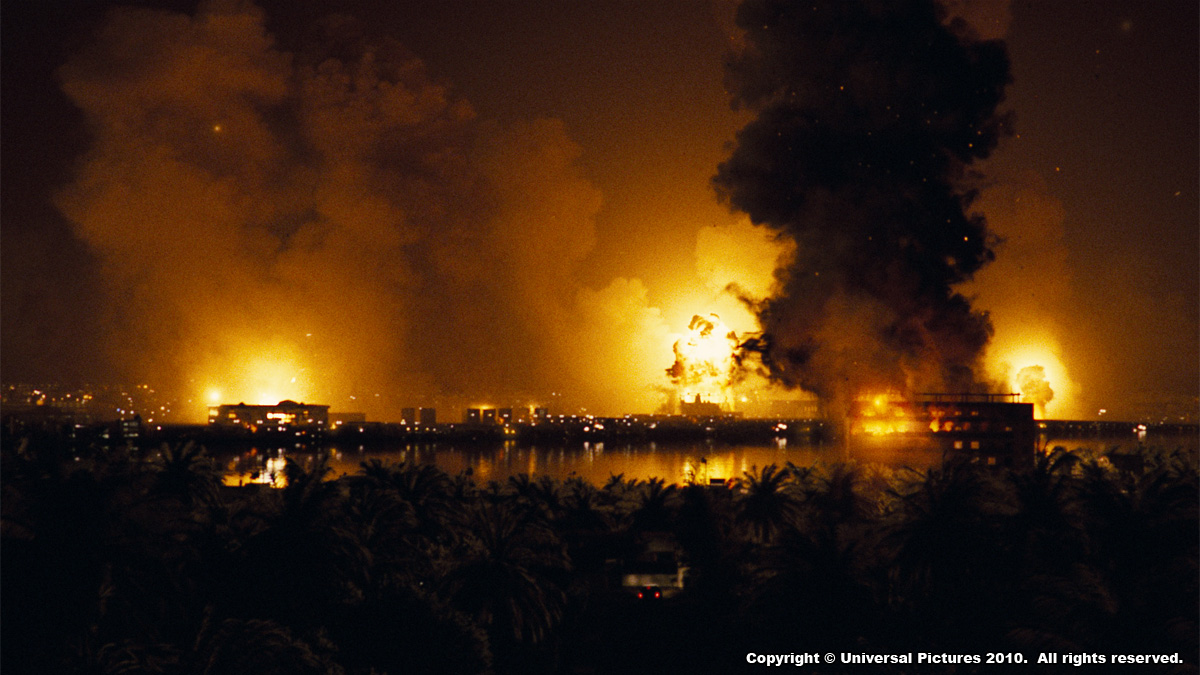
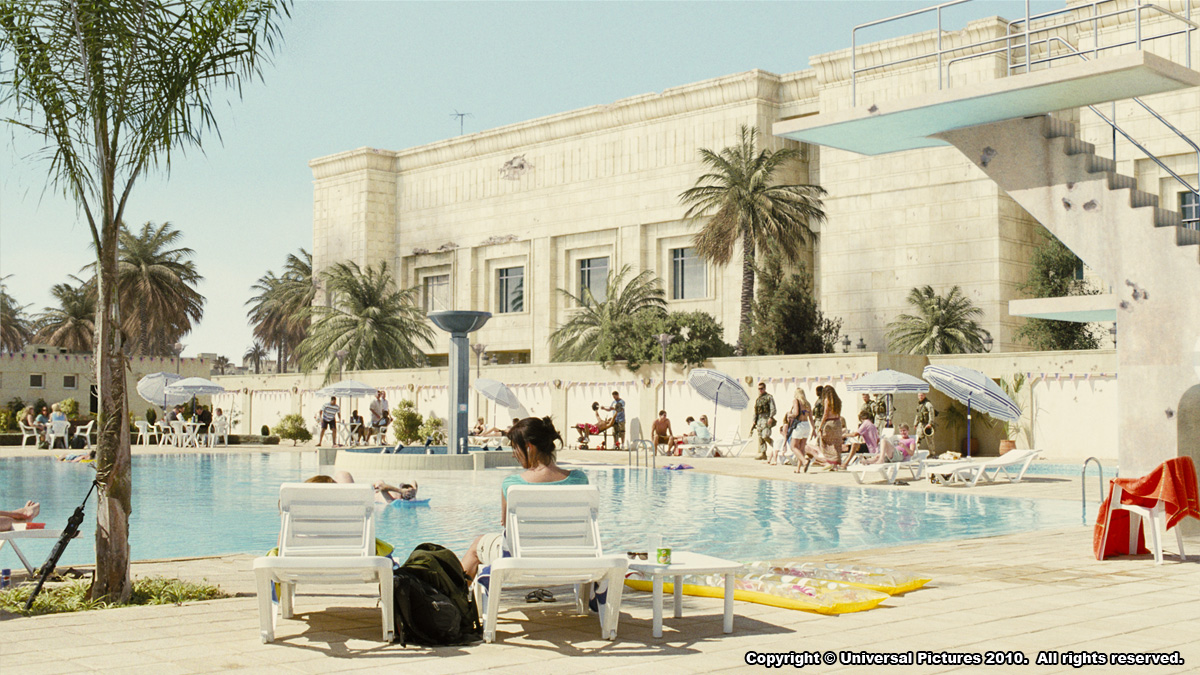





thanks vincent for all your spirit and energy!! great and very interesting article.
Awesome article! I love the before and after, please post more similar articles with visual compositing breakdowns/before/after, etc…
article excellent une fois de plus..merci pour ton travail!